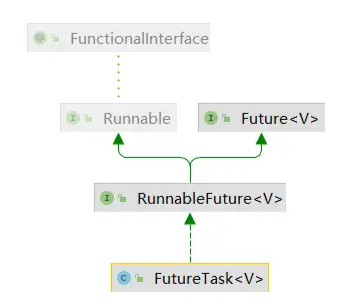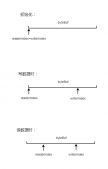前言:
大家是否熟悉FutureTask呢?或者说你有没有异步计算的需求呢?FutureTask就能够很好的帮助你实现异步计算,并且可以实现同步获取异步任务的计算结果。下面我们就一起从源码分析一下FutureTask。
了解一下什么是FutureTask?
FutureTask 是一个可取消的异步计算。
FutureTask提供了对Future的基本实现,可以调用方法去开始和取消一个计算,可以查询计算是否完成,并且获取计算结果。
FutureTask只能在计算完成后获取到计算结果,一旦计算完成,将不能重启或者取消,除非调用runAndReset方法。
FutureTask除了实现了Future接口以外,还实现了Runnable接口,因此FutureTask是可以交由线程池的Executor执行,也可以直接使用一个异步线程调用执行(futureTask.run())。
FutureTask 是如何实现的呢?
首先,我们看一下FutureTask类的继承结构,如下图,它实现的是RunnableFuture接口,而RunnableFuture继承自Future和函数式接口Runnable,所以说FutureTask本质就是一个可运行的Future。

Future 接口约定了一些异步计算类必须要实现的功能,源码如下:
|
1
2
3
4
5
6
7
8
9
10
11
12
13
14
15
16
17
18
19
20
21
22
23
24
25
|
package java.util.concurrent;public interface Future<V> { /** * 尝试取消任务的执行,并返回取消结果。 * 参数mayInterruptIfRunning:是否中断线程。 */ boolean cancel(boolean mayInterruptIfRunning); /** * 判断任务是否被取消(正常结束之前被被取消返回true) */ boolean isCancelled(); /** * 判断当前任务是否执行完毕,包括正常执行完毕、执行异常或者任务取消。 */ boolean isDone(); /** * 获取任务执行结果,任务结束之前会阻塞。 */ V get() throws InterruptedException, ExecutionException; /** * 在指定时间内尝试获取执行结果。若超时则抛出超时异常TimeoutException */ V get(long timeout, TimeUnit unit) throws InterruptedException, ExecutionException, TimeoutException;} |
Runnable 接口我们都很熟悉,他就是一个函数式接口,我们常用其创建一个线程。
|
1
2
3
4
5
6
7
|
package java.lang;@FunctionalInterfacepublic interface Runnable { public abstract void run();} |
FutureTask就是一个将要被执行的任务,它包含了以上接口具体的实现,FutureTask内部定义了任务的状态state和一些状态的常量,它的内部核心是一个Callable callable,我们通过构造函数可以传入callable或者是runnable,最后都会内部转为callable,因为我们需要获取异步任务的执行结果,只有通过Callable创建的线程才会返回结果。
我们可以通过此时的状态判断Future中isCancelled(),isDone()的返回结果。
以下为FutureTask源码,内含核心源码分析注释
|
1
2
3
4
5
6
7
8
9
10
11
12
13
14
15
16
17
18
19
20
21
22
23
24
25
26
27
28
29
30
31
32
33
34
35
36
37
38
39
40
41
42
43
44
45
46
47
48
49
50
51
52
53
54
55
56
57
58
59
60
61
62
63
64
65
66
67
68
69
70
71
72
73
74
75
76
77
78
79
80
81
82
83
84
85
86
87
88
89
90
91
92
93
94
95
96
97
98
99
100
101
102
103
104
105
106
107
108
109
110
111
112
113
114
115
116
117
118
119
120
121
122
123
124
125
126
127
128
129
130
131
132
133
134
135
136
137
138
139
140
141
142
143
144
145
146
147
148
149
150
151
152
153
154
155
156
157
158
159
160
161
162
163
164
165
166
167
168
169
170
171
172
173
174
175
176
177
178
179
180
181
182
183
184
185
186
187
188
189
190
191
192
193
194
195
196
197
198
199
200
201
202
203
204
205
206
207
208
209
210
211
212
213
214
215
216
217
218
219
220
221
222
223
224
225
226
227
228
229
230
231
232
233
234
235
236
237
238
239
240
241
242
243
244
245
246
247
248
249
250
251
252
253
254
255
256
257
258
259
260
261
262
263
264
265
266
267
268
269
270
271
272
273
274
275
276
277
278
279
280
281
282
283
284
285
286
287
288
289
290
291
292
293
294
295
296
297
298
299
300
301
302
303
304
305
|
package java.util.concurrent;import java.util.concurrent.locks.LockSupport;public class FutureTask<V> implements RunnableFuture<V> { /** * 任务的运行状态 */ private volatile int state; private static final int NEW = 0; // 新建 private static final int COMPLETING = 1; // 完成 private static final int NORMAL = 2; // 正常 private static final int EXCEPTIONAL = 3; // 异常 private static final int CANCELLED = 4; // 取消 private static final int INTERRUPTING = 5; // 中断中 private static final int INTERRUPTED = 6; // 中断的 private Callable<V> callable; /** * 返回结果 */ private Object outcome; private volatile Thread runner; private volatile WaitNode waiters; ... public FutureTask(Callable<V> callable) { if (callable == null) throw new NullPointerException(); this.callable = callable; this.state = NEW; } public FutureTask(Runnable runnable, V result) { this.callable = Executors.callable(runnable, result); this.state = NEW; } public boolean isCancelled() { return state >= CANCELLED; } public boolean isDone() { return state != NEW; } /* * 取消任务实现 * 如果任务还没有启动就调用了cancel(true),任务将永远不会被执行。 * 如果任务已经启动,参数mayInterruptIfRunning将决定任务是否应该中断执行该任务的线程,以尝试中断该任务。 * 如果任务任务已经取消、已经完成或者其他原因不能取消,尝试将失败。 */ public boolean cancel(boolean mayInterruptIfRunning) { if (!(state == NEW && UNSAFE.compareAndSwapInt(this, stateOffset, NEW, mayInterruptIfRunning ? INTERRUPTING : CANCELLED))) return false; try { // in case call to interrupt throws exception if (mayInterruptIfRunning) { try { Thread t = runner; if (t != null) t.interrupt(); } finally { // final state UNSAFE.putOrderedInt(this, stateOffset, INTERRUPTED); } } } finally { finishCompletion(); } return true; } /* * 等待获取结果 * 获取当前状态,判断是否执行完成。并且判断时间是否超时 * 如果任务没有执行完成,就阻塞等待完成,若超时抛出超时等待异常。 */ public V get() throws InterruptedException, ExecutionException { int s = state; if (s <= COMPLETING) s = awaitDone(false, 0L); return report(s); } /* * 等待获取结果 * 获取当前状态,判断是否执行完成。 * 如果任务没有执行完成,就阻塞等待完成。 */ public V get(long timeout, TimeUnit unit) throws InterruptedException, ExecutionException, TimeoutException { if (unit == null) throw new NullPointerException(); int s = state; if (s <= COMPLETING && (s = awaitDone(true, unit.toNanos(timeout))) <= COMPLETING) throw new TimeoutException(); return report(s); } /** * 根据状态判断返回结果还是异常 */ private V report(int s) throws ExecutionException { Object x = outcome; if (s == NORMAL) return (V)x; if (s >= CANCELLED) throw new CancellationException(); throw new ExecutionException((Throwable)x); } protected void done() { } /** * 设置结果借助CAS确认状态是否完成状态 */ protected void set(V v) { if (UNSAFE.compareAndSwapInt(this, stateOffset, NEW, COMPLETING)) { outcome = v; UNSAFE.putOrderedInt(this, stateOffset, NORMAL); // final state finishCompletion(); } } /** * 设置异常,当运行完成出现异常,设置异常状态 */ protected void setException(Throwable t) { if (UNSAFE.compareAndSwapInt(this, stateOffset, NEW, COMPLETING)) { outcome = t; UNSAFE.putOrderedInt(this, stateOffset, EXCEPTIONAL); // final state finishCompletion(); } } /* * 执行callable获取结果,或者异常 * 判断状态是不是启动过的,如果是新建才可以执行run方法 */ public void run() { if (state != NEW || !UNSAFE.compareAndSwapObject(this, runnerOffset, null, Thread.currentThread())) return; try { Callable<V> c = callable; if (c != null && state == NEW) { V result; boolean ran; try { result = c.call(); ran = true; } catch (Throwable ex) { result = null; ran = false; setException(ex); } if (ran) set(result); } } finally { runner = null; int s = state; if (s >= INTERRUPTING) handlePossibleCancellationInterrupt(s); } } /** * 重新执行 */ protected boolean runAndReset() { if (state != NEW || !UNSAFE.compareAndSwapObject(this, runnerOffset, null, Thread.currentThread())) return false; boolean ran = false; int s = state; try { Callable<V> c = callable; if (c != null && s == NEW) { try { c.call(); // don't set result ran = true; } catch (Throwable ex) { setException(ex); } } } finally { runner = null; s = state; if (s >= INTERRUPTING) handlePossibleCancellationInterrupt(s); } return ran && s == NEW; } /* * 处理可能取消的中断 */ private void handlePossibleCancellationInterrupt(int s) { if (s == INTERRUPTING) while (state == INTERRUPTING) Thread.yield(); } static final class WaitNode { volatile Thread thread; volatile WaitNode next; WaitNode() { thread = Thread.currentThread(); } } /** * 移除并唤醒所有等待线程,执行done,置空callable */ private void finishCompletion() { // assert state > COMPLETING; for (WaitNode q; (q = waiters) != null;) { if (UNSAFE.compareAndSwapObject(this, waitersOffset, q, null)) { for (;;) { Thread t = q.thread; if (t != null) { q.thread = null; LockSupport.unpark(t); } WaitNode next = q.next; if (next == null) break; q.next = null; // unlink to help gc q = next; } break; } } done(); callable = null; // to reduce footprint } /** * 等待完成 * 首先判断是否超时 * 处理中断的,然后处理异常状态的,处理完成的... */ private int awaitDone(boolean timed, long nanos) throws InterruptedException { final long deadline = timed ? System.nanoTime() + nanos : 0L; WaitNode q = null; boolean queued = false; for (;;) { if (Thread.interrupted()) { removeWaiter(q); throw new InterruptedException(); } int s = state; if (s > COMPLETING) { if (q != null) q.thread = null; return s; } else if (s == COMPLETING) // cannot time out yet Thread.yield(); else if (q == null) q = new WaitNode(); else if (!queued) queued = UNSAFE.compareAndSwapObject(this, waitersOffset, q.next = waiters, q); else if (timed) { nanos = deadline - System.nanoTime(); if (nanos <= 0L) { removeWaiter(q); return state; } LockSupport.parkNanos(this, nanos); } else LockSupport.park(this); } } /** * 去除等待 */ private void removeWaiter(WaitNode node) { if (node != null) { node.thread = null; retry: for (;;) { // restart on removeWaiter race for (WaitNode pred = null, q = waiters, s; q != null; q = s) { s = q.next; if (q.thread != null) pred = q; else if (pred != null) { pred.next = s; if (pred.thread == null) // check for race continue retry; } else if (!UNSAFE.compareAndSwapObject(this, waitersOffset, q, s)) continue retry; } break; } } } // Unsafe mechanics private static final sun.misc.Unsafe UNSAFE; private static final long stateOffset; private static final long runnerOffset; private static final long waitersOffset; static { try { UNSAFE = sun.misc.Unsafe.getUnsafe(); Class<?> k = FutureTask.class; stateOffset = UNSAFE.objectFieldOffset (k.getDeclaredField("state")); runnerOffset = UNSAFE.objectFieldOffset (k.getDeclaredField("runner")); waitersOffset = UNSAFE.objectFieldOffset (k.getDeclaredField("waiters")); } catch (Exception e) { throw new Error(e); } }} |
FutureTask 运行流程
一般来说,我们可以认为FutureTask具有以下三种状态:
未启动:新建的FutureTask,在run()没执行之前,FutureTask处于未启动状态。
|
1
|
private static final int NEW = 0; // 新建 |
已启动:FutureTask对象的run方法启动并执行的过程中,FutureTask处于已启动状态。
已完成:FutureTask正常执行结束,或者FutureTask执行被取消(FutureTask对象cancel方法),或者FutureTask对象run方法执行抛出异常而导致中断而结束,FutureTask都处于已完成状态。
|
1
2
3
4
5
6
|
private static final int COMPLETING = 1; // 完成private static final int NORMAL = 2; // 完成后正常设置结果private static final int EXCEPTIONAL = 3; // 完成后异常设置异常private static final int CANCELLED = 4; // 执行取消private static final int INTERRUPTING = 5; // 中断中private static final int INTERRUPTED = 6; // 中断的 |
FutureTask 的使用
使用一(直接新建一个线程调用):
|
1
2
3
4
5
6
7
8
|
FutureTask<Integer> task = new FutureTask<>(new Callable() { @Override public Integer call() throws Exception { return sum(); }});new Thread(task).stat();Integer result = task.get(); |
使用二(结合线程池使用)
|
1
2
3
4
5
6
7
8
|
FutureTask<Integer> task = new FutureTask<>(new Callable() { @Override public Integer call() throws Exception { return sum(); }});Executors.newCachedThreadPool().submit(task);Integer result = task.get(); |
到此这篇关于Java从源码看异步任务计算FutureTask的文章就介绍到这了,更多相关Java FutureTask内容请搜索服务器之家以前的文章或继续浏览下面的相关文章希望大家以后多多支持服务器之家!
原文链接:https://juejin.cn/post/7062980018208669709















